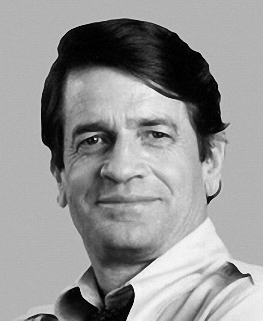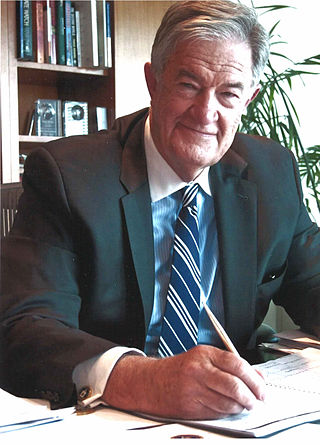
The FIM-92 Stinger is an American man-portable air-defense system (MANPADS) that operates as an infrared homing surface-to-air missile (SAM). It can be adapted to fire from a wide variety of ground vehicles, and from helicopters as the Air-to-Air Stinger (ATAS). It entered service in 1981 and is used by the militaries of the United States and 29 other countries. It is principally manufactured by Raytheon Missiles & Defense and is produced under license by Airbus Defence and Space in Germany and by Roketsan in Turkey.

The Reagan Doctrine was stated by United States President Ronald Reagan in his State of the Union address on February 6, 1985: "We must not break faith with those who are risking their lives—on every continent from Afghanistan to Nicaragua—to defy Soviet-supported aggression and secure rights which have been ours from birth." It was a strategy implemented by the Reagan Administration to overwhelm the global influence of the Soviet Union in the late Cold War. The doctrine was a centerpiece of United States foreign policy from the early 1980s until the end of the Cold War in 1991.

Charles Nesbitt Wilson was an American politician and naval officer who was a 12-term Democratic Representative from Texas's 2nd congressional district. Wilson is best known for leading Congress into supporting Operation Cyclone, the largest-ever Central Intelligence Agency (CIA) covert operation, which during the Carter and Reagan administrations supplied military equipment to the Afghan Mujahideen during the Soviet–Afghan War. His behind-the-scenes campaign was the subject of the non-fiction book Charlie Wilson's War: The Extraordinary Story of the Largest Covert Operation in History by George Crile III and the subsequent film Charlie Wilson's War, in which he was portrayed by Tom Hanks.
{{Infobox officeholder | honorific_prefix = General | name = Akhtar Abdur Rahman | honorific_suffix = NI(M) HI(M) TI(M) SBt | image = | order1 = 5th Chairman Joint Chiefs of Staff Committee | term_start1 = 29 March 1987 | term_end1 = 17 August 1988 | predecessor1 = Rahimuddin Khan | successor1 = Iftikhar Ahmed Sirohey | order2 = 7th Director-General of Inter-Services Intelligence | term_start2 = 21 June 1979 | term_end2 = 29 March 1987 | predecessor2 = Muhammad Riaz Khan | successor2 = Hamid Gul | order3 = Adjutant general GHQ | term_start3 = 1977 | term_end3 = 1979 | order4 = General Officer Commanding (GOC) of the 12th Infantry Division | term_start4 = 1974 | term_end4 = 1977 | birth_date = 11 June 1924 | birth_place = Peshawar, British India(now in Khyber Pakhtunkhwa, Pakistan) | spouse = Rashida Akhtar Khan | children = Akbar Akhtar Khan, Humayun Akhtar Khan, Haroon Akhtar Khan, Ghazi Akhtar Khan | death_date = 17 August 1988 (aged 64) | death_place = Bahawalpur, Pakistan | death_cause = Plane crash | alma_mater = Government College University Faisalabad | occupation = [[ Army Officer, Intelligence Officer | allegiance = Pakistan | branch = Pakistan Army | serviceyears = 1947–1988 | rank = General | commands = 45 Field Regiment Artillery, Artillery Headquarters of 4 Corps, GOC 12th Army Division, Murree
DG Inter-Services Intelligence (ISI) | unit = 45 Field Regiment Artillery | battles = Indo-Pakistan War of 1948
Indo-Pakistan War of 1965
Indo-Pakistan War of 1971
Soviet–Afghan War | awards = Sitara-e-Basalat | mawards = Nishan-e-Imtiaz (Military)
Hilal-e-Imtiaz (Military)
Sitara-e-Basalat
Tamgha-e-Imtiaz (Military) }}
The military industry of Egypt produces defense and security products that range from "small arms to armored vehicles to naval vessels" for the Egyptian Armed Forces and export. Egypt also has co-production agreements with several countries, including the United States and France.

Gust Lascaris Avrakotos was an American case officer and the Afghan Task Force Chief for the Central Intelligence Agency.

Charlie Wilson's War is a 2007 American biographical comedy-drama film based on the story of U.S. Congressman Charlie Wilson and CIA operative Gust Avrakotos, whose efforts led to Operation Cyclone, a program to organize and support the Afghan mujahideen during the Soviet–Afghan War (1979–1989).

George Washington Crile III was an American journalist most closely associated with his three decades of work at CBS News. He specialized in dangerous and controversial subjects, resulting in both praise and controversy. He received an Emmy Award, Peabody Award, and Edward R. Murrow Award.

Operation Cyclone was the code name for the United States Central Intelligence Agency (CIA) program to arm and finance the Afghan mujahideen in Afghanistan from 1979 to 1992, prior to and during the military intervention by the USSR in support of the Democratic Republic of Afghanistan. The mujahideen were also supported by Britain's MI6, who conducted their own separate covert actions. The program leaned heavily towards supporting militant Islamic groups, including groups with jihadist ties, that were favored by the regime of Muhammad Zia-ul-Haq in neighboring Pakistan, rather than other, less ideological Afghan resistance groups that had also been fighting the Soviet-oriented Democratic Republic of Afghanistan administration since before the Soviet intervention.
The Soviet–Afghan War had an important impact in popular culture in the West, due to its scope, and the great number of countries involved. The Russian-Ukrainian film The 9th Company, for example, became a blockbuster in the former USSR earning millions of dollars and also representing a new trend in Russia in which some domestic films are "drawing Russian audiences away from Hollywood staples." The use of the war in Russian cinema has attracted scholarly attention as well. Some of this attention focuses on comparisons of the conflict with other modern wars in Vietnam and Iraq. Other work focuses on the war and fictional accounts of it in the context of Soviet military culture. Even when not directly portrayed, service in the war is sometimes used as a backstory for Russian characters to explain their combat prowess, such as in the manga and anime series Black Lagoon.

Several sources have alleged that the Central Intelligence Agency (CIA) had ties with Osama bin Laden's faction of "Afghan Arab" fighters when it armed Mujahideen groups to fight the Soviet Union during the Soviet–Afghan War.
The Afghanistan conflict began in 1978 and has coincided with several notable operations by the United States (U.S.) Central Intelligence Agency (CIA). The first operation, code-named Operation Cyclone, began in mid-1979, during the Presidency of Jimmy Carter. It financed and eventually supplied weapons to the anti-communist mujahideen guerrillas in Afghanistan following an April 1978 coup by the People's Democratic Party of Afghanistan (PDPA) and throughout the nearly ten-year military occupation of Afghanistan by the Soviet Union (U.S.S.R.). Carter's successor, Ronald Reagan, supported an expansion of the Reagan Doctrine, which aided the mujahideen along with several other anti-Soviet resistance movements around the world.

Muhammad Abd Al-Halim Abu-Ghazala was Defense Minister of Egypt from 1981 to 1989. Abu Ghazala was seated next to Anwar Sadat when the president was assassinated.
There have been various arrangements to handle the Central Intelligence Agency's relationship with the United States Congress.

Michael Paul Pillsbury is a foreign policy strategist, author, and former public official in the United States. He is a senior fellow for China strategy at the The Heritage Foundation and has been Director of the Center on Chinese Strategy at the Hudson Institute in Washington, D.C. since 2014. Before Hudson, he held various postings in the U.S. Department of Defense and U.S. Senate. He has been called a "China-hawk", and an "architect" of Trump's signature policy on China.

Jack Devine is a veteran of the Central Intelligence Agency (CIA) and a founding partner and President of The Arkin Group LLC.
Charlie Wilson's War may refer to:
During the Soviet–Afghan War, there was a large amount of foreign involvement. The Afghan mujahidin were backed primarily by Pakistan, the United States, Saudi Arabia, and the United Kingdom making it a Cold War proxy war. Pakistani forces trained the mujahidin rebels while the U.S. and Saudi Arabia offered the greatest financial support. However, private donors and religious charities throughout the Muslim world—particularly in the Persian Gulf—raised considerably more funds for the Afghan rebels than any foreign government; Jason Burke recounts that "as little as 25 per cent of the money for the Afghan jihad was actually supplied directly by states." Saudi Arabia was heavily involved in the war effort and matched the United States' contributions dollar-for-dollar in public funds. Saudi Arabia also gathered an enormous amount of money for the Afghan mujahidin in private donations that amounted to about $20 million per month at their peak. Other countries that supported the Mujahidin were Egypt, China, and Iran, which only supported the Shia Mujahidin, namely the Persian-speaking Shia Hazaras in a limited way. One of these groups was the Tehran Eight, a political union of Afghan Shi'a. They were supplied predominately by the Islamic Revolutionary Guard Corps, but Iran's support for the Hazaras nevertheless frustrated efforts for a united Mujahidin front.

Though not officially a belligerent during the Soviet–Afghan War, the United Kingdom was heavily involved, playing a key covert role in the conflict. Also known as the Second Great Game, the British provided both indirect and direct support for the Afghan mujahideen in their fight against the Soviet Union, including secretly arming, funding and supplying various factions. Britain's Secret Intelligence Service (MI6) primarily supported the Mujahideen group Jamiat-e Islami, commanded by Ahmad Shah Massoud who, having received little support from the US and Pakistan, became Britain's key ally in the conflict. Fighting in the Panjshir valley, Massoud and his fighters with British support and intelligence, overcame nine Soviet offensives and held out up to the Soviet withdrawal from the vital valley in 1986. Massoud became the most successful and feared out of any of the Mujahideen commanders.













